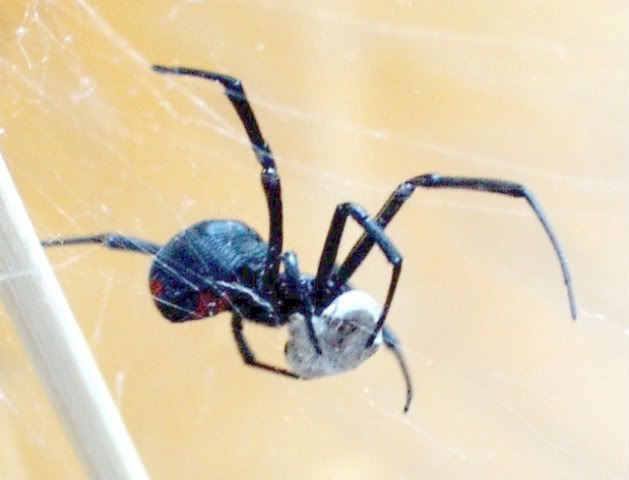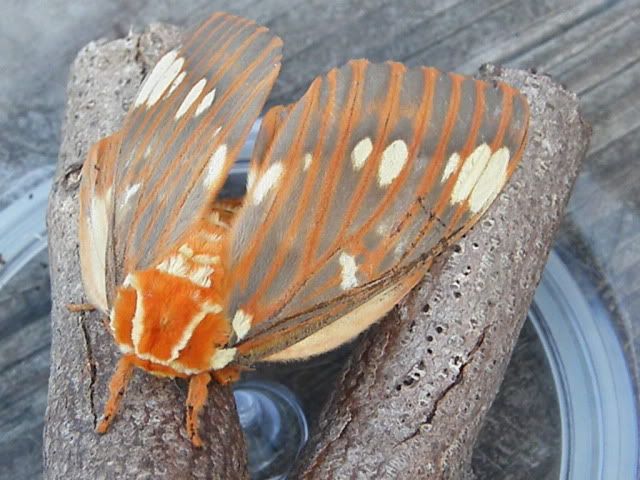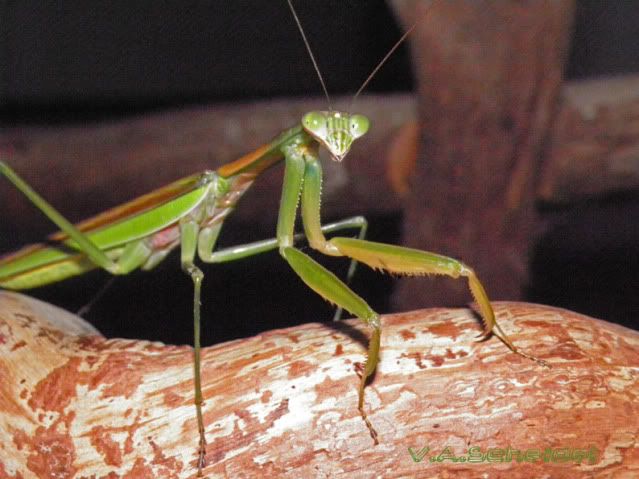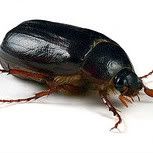BUGS!
Comments
-
eww I just got all crawly on my skin from your story....I ran into a black widow once by the water spicket outside...she had babies there too scary!
Man, I don't care how cute he looks, I would stomp his fuzzy little smiling head without a second thoughtajedigecko wrote:aww...i like him
wish all spiders looked like that
all fuzzy and smiling
Don't like me no part of a spider!!!!
Get this Pandi...so we head to the house for lunch the other day. I put the food in the nuker. I get up to retrieve it when its ready and she goes to the bathroom. As I enter the kitchen I see a funny looking black thing on the floor in the dimly lit area and bend over to check it out with my awful eyes. A HUGE NASTY UGLY SPIDER!!! I think I yelped like a frightened little school girl and she yells out what's wrong!! I'm kinda freaked, but was wearing flip-flops so I wasn't about to stomp it. She puts her shoes on and kicks it. It's dead. She sort of stomps it. BABY SPIDERS RUN EVERYWHERE!!!! It looked like we were tap dancing in there!!!
That wasn't good for my heart. SCREW A SPIDER!!!![/quote]i would suspect it to have been a wolf spider. 0
0 -
GOOD GOD!!!! WHY YOU POST THAT!!!! :shock: :shock: :wtf:pandora wrote:
eww I just got all crawly on my skin from your story....I ran into a black widow once by the water spicket outside...she had babies there too scary!
Man, I don't care how cute he looks, I would stomp his fuzzy little smiling head without a second thoughtajedigecko wrote:aww...i like him
wish all spiders looked like that
all fuzzy and smiling
Don't like me no part of a spider!!!!
Get this Pandi...so we head to the house for lunch the other day. I put the food in the nuker. I get up to retrieve it when its ready and she goes to the bathroom. As I enter the kitchen I see a funny looking black thing on the floor in the dimly lit area and bend over to check it out with my awful eyes. A HUGE NASTY UGLY SPIDER!!! I think I yelped like a frightened little school girl and she yells out what's wrong!! I'm kinda freaked, but was wearing flip-flops so I wasn't about to stomp it. She puts her shoes on and kicks it. It's dead. She sort of stomps it. BABY SPIDERS RUN EVERYWHERE!!!! It looked like we were tap dancing in there!!!
That wasn't good for my heart. SCREW A SPIDER!!!![/quote]i would suspect it to have been a wolf spider.
Everytime I thought about that the rest of the day I shuddered!!
And yeah, Jedi, me thinks it was a wolf spider as well, but it doesn't matter what kind!!All I have to do is revel in the everyday....then do it again tomorrow
They say every sin is deadly but I believe they may be wrong...I'm guilty of all seven and I don't feel too bad at all0 -
bugs always make me laugh :lolno:
http://www.youtube.com/watch?v=wsTXumUC3jg
http://www.youtube.com/watch?v=e8TUwHTfOOUfor poetry through the ceiling. ISBN: 1 4241 8840 7
"Hear me, my chiefs!
I am tired; my heart is
sick and sad. From where
the sun stands I will fight
no more forever."
Chief Joseph - Nez Perce0 -
http://www.youtube.com/watch?v=FNQirvqDf7U


Seems the philly area has been bombarded with these guys lately 8/28/98- Camden, NJ
8/28/98- Camden, NJ
10/31/09- Philly
5/21/10- NYC
9/2/12- Philly, PA
7/19/13- Wrigley
10/19/13- Brooklyn, NY
10/21/13- Philly, PA
10/22/13- Philly, PA
10/27/13- Baltimore, MD
4/28/16- Philly, PA
4/29/16- Philly, PA
5/1/16- NYC
5/2/16- NYC
9/2/18- Boston, MA
9/4/18- Boston, MA
9/14/22- Camden, NJ
9/7/24- Philly, PA
9/9/24- Philly, PATres Mts.- 3/23/11- Philly. PA
Eddie Vedder- 6/25/11- Philly, PA
RNDM- 3/9/16- Philly, PA0 -
I had somebody similar ride home with me 30 miles on the freeway.eeriepadave wrote: http://www.youtube.com/watch?v=FNQirvqDf7U
http://www.youtube.com/watch?v=FNQirvqDf7U 

Seems the philly area has been bombarded with these guys lately
I thought he blew off then I see him snuggled into a hiding place by the windshield wiper.
I hope he didn't have a family, maybe he did and that was the point!
Free!!
thanks for the Bugs I was there what a night!0 -
 Pretty!!
Pretty!!
The regal moth (Citheronia regalis), also called the royal walnut moth, is a North American moth in the saturniidae family. The caterpillars are called hickory horned devils. The adult (Imago) has a wingspan of 9.5-15.5 cm.
Life cycle 8-)
Citheronia regalis is an impressive creature in all stages of development. The adult moth is the largest (in mass, not wing area) north of Mexico, as are the spectacular larva and the substantial pupa.
The life cycle of the moth is much like any other Saturniidae species, and typical of the Ceratocampidae, it burrows into the ground to pupate in an earthen chamber, rather than spinning a cocoon.
Yellowish eggs, oval and 2 mm in diameter, are laid either singly or in groups of up to four on the upper surface of the host plant leaves, favoring nut trees such as Juglans and Carya (walnut and hickories). There are regional preferences, with the utilization of sweet gum and persimmon in the south, and sumacs where the others are not available. Larvae are solitary in later stages and rarely occur in numbers large enough to cause defoliation, however an individual larva can strip several branches of their leaves during the ravenous 5th instar. When the eggs hatch 7-10 days later, small yellow larvae that darken rapidly emerge. The caterpillars are solitary nighttime feeders in early stages, when they curl up in a "j" shaped pattern during the day and resemble two-toned bird droppings.
As the caterpillars age, they feed during the day. They molt 5 times. Each instar is different, but on their sixth and final instar they become a bright green color, with huge black-tipped red horns, earning them their common name "hickory horned devils". They feed heavily on their host plant and can grow up to 15cm long. Their scary appearance is purely a ruse; the spines, though prickly, do not sting, and the larva is harmless and actually one of the more easily handled of the saturniidae.
Just before pupation, the larva expels its gut and changes color from Frankenstein-green to a more fetching turquoise, the skin of the fully fed creature stretched shiny and tight. They then crawl down the host plant, where they burrow into the dirt and pupate in a well formed chamber. The pupae are dark brown/black in color, and have a relatively short cremaster. Some pupae overwinter for 2 seasons, perhaps as an adaption to variable and adverse conditions such as fires and flooding, or to maintain genetic diversity across generations.
When the moths eclose, they have to pump their wings with fluid (hemolymph) to extend them. The females emit pheromones, which the male can detect through its large, plumose antennae. Males can fly for miles in order to reach a female. After the moths mate, the female spends the majority of the remainder of her life laying eggs, while the male may mate several more times. Adults of this family of moths have vestigal mouths, meaning their mouthparts have been reduced. Because of this, they do not eat and only live for about a week as adults.
There is a single generation of regalis throughout its range, but in the deep south, moths have been recorded throughout the longer growing season. Typically, Citheronia regalis is a midsummer moth, on the wing from late June through August. There is a distinct bell curve to the emergence, with peak-weeks coinciding with the first spell of the humid summer weather which may synchronize emergences.0 -


Monarchs are especially noted for their lengthy annual migration. In North America they make massive southward migrations starting in August until the first frost. A northward migration takes place in the spring. The monarch is the only butterfly that migrates both north and south as the birds do on a regular basis. But no single individual makes the entire round trip. Female monarchs deposit eggs for the next generation during these migrations.
The length of these journeys exceeds the normal lifespan of most monarchs, which is less than two months for butterflies born in early summer. The last generation of the summer enters into a non-reproductive phase known as diapause and may live seven months or more. During diapause, butterflies fly to one of many overwintering sites. The generation that overwinters generally does not reproduce until it leaves the overwintering site sometime in February and March. 0
0 -
pandora & others who care,
wanna hear about when some monarchs migrated through iowa flying, sailing along straight through our place?
here goes...
i hope i do not boar you to death...
it was an incredible afternoon. iowa sunshine and harvesting soon. then... in the blink of an eye, monarch butterflies forever.... yes,,, i said almost forever... 30-50 feet thick, up and down, vertical mountainous flight of color, black/orange & yellow...black, orange & yellow about 20 feet off ground, up... many hundreds of feet wide, perhaps 100 yards,, and several miles long... about 1 or 2 hours worth of monarch speedway boogie through our iowa country home.
i was in the frontyard... like a squirrel all over it, i climbed up into our old tree house where were played and slept when we were kids, i then escaped from tree house station, got on the garage and house roof...
chadiest among monarch butterflies by the 400,000,000,000,000 wing and throbbing groins of travel and caterpillar...
3 monarchs shit in my hair
that is all...
carry onPost edited by chadwick onfor poetry through the ceiling. ISBN: 1 4241 8840 7
"Hear me, my chiefs!
I am tired; my heart is
sick and sad. From where
the sun stands I will fight
no more forever."
Chief Joseph - Nez Perce0 -
My most favorite bug other than that Praying Mantis is the 17 year Cicada. They come out every 17 years, the last time 1n 2004 and before that 1987 and when they do come to life they came make the most hellish mating call ever. It sounds like a 24-7 siren!
http://www.seventeenyearcicada.com/imag ... 50x287.jpg
More on this very unique bug... http://www.seventeenyearcicada.com/
Cicadas facts
Cicadas are members of the Hemiptera, then the Homoptera, the Homoptera is often considered an order in its own rite these days but in some books you will find it designated as a suborder of the Hemiptera. They are then members of the superfamily Cicadoidea, and the Family Cicadidae. There are about 1600 species of Cicada in the world, some of the largest are in the genera Pomponia and Tacua.
Cicadas are mainly warm-temperate to tropical in habitat. There are around 200 species in Australia compared with about 100 species in the Palaearctic and only 1 species in the UK. The British species is Melampsalta montana (was Cicadetta) which is widespread outside of the UK.
Generally speaking cicadas have life cycles that last from one to several years, most of this time is spent as a nymph under the ground feeding on the xylem fluids of plants by piercing their roots and sucking out the fluids. Some species take a very long time to develop and the periodical cicadas of the genus Magicicada of North America are well known because some of them have a 17 cicades year life cycle. Cicades can be found in Tennessee, Ohio, Virginia, Kentucky, Illinois and other parts of the US like some parts of the Mississippi.
There are 3 species of periodical cicada, each of which has two forms, a 17 year form and a 13 year form; they are Magicicada septendecim, Magicicada septendecula and Magicicada cassini. Some authorities claim that the 13 year form of each species should be a species in its own rite, in this case they are named; Magicicada tredecim, Magicicada tredecassini and Magicicada tredecula. Of the three species (called Decim, Cassini and Decula for short) Decim is the most common in the north of their range, Decula is rare all over and Cassini is most common around the Mississippi valley.
The common names for cicadas vary widely around the world. In Australia, children were the first to coin the common name for many cicadas - names that have been dutifully passed down from generation to generation of cicada hunters.
Probably the best known and most mysterious is the Black Prince (Psaltoda plaga) followed closely by the Green Grocer (Cyclochila australasiae). Other popular names include the Double Drummer (Thopha saccata), Redeye (Psaltoda moerens), Floury Baker (Abricta curvicosta) and Cherrynose (Macrotristria angularis).
Two other common names becoming more widely accepted are Hairy Cicada (Tettigarcta tomentosa and T. crinita) and Bladder Cicada (Cystosoma saundersi). The exact origin of most of these names is unclear, but also the Yellow Monday and Green Grocer were in popular.
Peace*We CAN bomb the World to pieces, but we CAN'T bomb it into PEACE*...Michael Franti
*MUSIC IS the expression of EMOTION.....and that POLITICS IS merely the DECOY of PERCEPTION*
.....song_Music & Politics....Michael Franti
*The scientists of today think deeply instead of clearly. One must be sane to think clearly, but one can think deeply and be quite INSANE*....Nikola Tesla(a man who shaped our world of electricity with his futuristic inventions)0 -
Have also been known to catch and consume hummingbirds as well....seriously.pandora wrote: :wave: Mantis religiosa
:wave: Mantis religiosa
The praying mantis is named for its prominent front legs, which are bent and held together at an angle that suggests the position of prayer. The larger group of these insects is more properly called the praying mantids. Mantis refers to the genus mantis, to which only some praying mantids belong.
By any name, these fascinating insects are formidable predators. They have triangular heads poised on a long "neck," or elongated thorax. Mantids can turn their heads 180 degrees to scan their surroundings with two large compound eyes and three other simple eyes located between them.
Typically green or brown and well camouflaged on the plants among which they live, mantis lie in ambush or patiently stalk their quarry. They use their front legs to snare their prey with reflexes so quick that they are difficult to see with the naked eye. Their legs are further equipped with spikes for snaring prey and pinning it in place.
Moths, crickets, grasshoppers, flies, and other insects are usually the unfortunate recipients of unwanted mantid attention. However, the insects will also eat others of their own kind. The most famous example of this is the notorious mating behavior of the adult female, who sometimes eats her mate just after—or even during—mating. Yet this behavior seems not to deter males from reproduction.
Females regularly lay hundreds of eggs in a small case, and nymphs hatch looking much like tiny versions of their parents.
Average life span in the wild:
12 months
Size:
0.5 to 6 in (1.2 to 15 cm) long
GOT A BUG TO ADD?! All the world will be your enemy, Prince with a thousand enemies, and whenever they catch you, they will kill you. But first they must catch you, digger, listener, runner, prince with the swift warning. Be cunning and full of tricks and your people shall never be destroyed.0
All the world will be your enemy, Prince with a thousand enemies, and whenever they catch you, they will kill you. But first they must catch you, digger, listener, runner, prince with the swift warning. Be cunning and full of tricks and your people shall never be destroyed.0 -
-
Ron: I just don't feel like going out tonight
Sammi: Wanna just break up?0 -
yeah i read that the other day.tybird wrote:
Have also been known to catch and consume hummingbirds as well....seriously.pandora wrote: :wave: Mantis religiosa
:wave: Mantis religiosa
The praying mantis is named for its prominent front legs, which are bent and held together at an angle that suggests the position of prayer. The larger group of these insects is more properly called the praying mantids. Mantis refers to the genus mantis, to which only some praying mantids belong.
By any name, these fascinating insects are formidable predators. They have triangular heads poised on a long "neck," or elongated thorax. Mantids can turn their heads 180 degrees to scan their surroundings with two large compound eyes and three other simple eyes located between them.
Typically green or brown and well camouflaged on the plants among which they live, mantis lie in ambush or patiently stalk their quarry. They use their front legs to snare their prey with reflexes so quick that they are difficult to see with the naked eye. Their legs are further equipped with spikes for snaring prey and pinning it in place.
Moths, crickets, grasshoppers, flies, and other insects are usually the unfortunate recipients of unwanted mantid attention. However, the insects will also eat others of their own kind. The most famous example of this is the notorious mating behavior of the adult female, who sometimes eats her mate just after—or even during—mating. Yet this behavior seems not to deter males from reproduction.
Females regularly lay hundreds of eggs in a small case, and nymphs hatch looking much like tiny versions of their parents.
Average life span in the wild:
12 months
Size:
0.5 to 6 in (1.2 to 15 cm) long
GOT A BUG TO ADD?!
praying mantis can totally screw over a hummingbird.
that pretty wild stuff.for poetry through the ceiling. ISBN: 1 4241 8840 7
"Hear me, my chiefs!
I am tired; my heart is
sick and sad. From where
the sun stands I will fight
no more forever."
Chief Joseph - Nez Perce0 -
pandora wrote:ajedigecko wrote:i like jumping spiders..........i know ,i know.....do not get technical.

found a kind of cute one I think he's smiling
I think he's smiling
awwwwwwwwwwwwww.
think i saw him drinking in the cantina at mos eisley. 8-)hear my name
take a good look
this could be the day
hold my hand
lie beside me
i just need to say0 -
Wonderfully descriptive, coolly written, lucky to be there, once in a lifetime experience! Thanks Chadchadwick wrote:pandora & others who care,
wanna hear about when some monarchs migrated through iowa flying, sailing along straight through our place?
here goes...
i hope i do not boar you to death...
it was an incredible afternoon. iowa sunshine and harvesting soon. then... in the blink of an eye, monarch butterflies forever.... yes,,, i said almost forever... 30-50 feet thick, up and down, vertical mountainous flight of color, black/orange & yellow...black, orange & yellow about 20 feet off ground, up... many hundreds of feet wide, perhaps 100 yards,, and several miles long... about 1 or 2 hours worth of monarch speedway boogie through our iowa country home.
i was in the frontyard... like a squirrel all over it, i climbed up into our old tree house where were played and slept when we were kids, i then escaped from tree house station, got on the garage and house roof...
chadiest among monarch butterflies by the 400,000,000,000,000 wing and throbbing groins of travel and caterpillar...
3 monarchs shit in my hair
that is all...
carry on 0
0 -
Thanks!g under p wrote:My most favorite bug other than that Praying Mantis is the 17 year Cicada. They come out every 17 years, the last time 1n 2004 and before that 1987 and when they do come to life they came make the most hellish mating call ever. It sounds like a 24-7 siren!
http://www.seventeenyearcicada.com/imag ... 50x287.jpg
More on this very unique bug... http://www.seventeenyearcicada.com/
Cicadas facts
Cicadas are members of the Hemiptera, then the Homoptera, the Homoptera is often considered an order in its own rite these days but in some books you will find it designated as a suborder of the Hemiptera. They are then members of the superfamily Cicadoidea, and the Family Cicadidae. There are about 1600 species of Cicada in the world, some of the largest are in the genera Pomponia and Tacua.
Cicadas are mainly warm-temperate to tropical in habitat. There are around 200 species in Australia compared with about 100 species in the Palaearctic and only 1 species in the UK. The British species is Melampsalta montana (was Cicadetta) which is widespread outside of the UK.
Generally speaking cicadas have life cycles that last from one to several years, most of this time is spent as a nymph under the ground feeding on the xylem fluids of plants by piercing their roots and sucking out the fluids. Some species take a very long time to develop and the periodical cicadas of the genus Magicicada of North America are well known because some of them have a 17 cicades year life cycle. Cicades can be found in Tennessee, Ohio, Virginia, Kentucky, Illinois and other parts of the US like some parts of the Mississippi.
There are 3 species of periodical cicada, each of which has two forms, a 17 year form and a 13 year form; they are Magicicada septendecim, Magicicada septendecula and Magicicada cassini. Some authorities claim that the 13 year form of each species should be a species in its own rite, in this case they are named; Magicicada tredecim, Magicicada tredecassini and Magicicada tredecula. Of the three species (called Decim, Cassini and Decula for short) Decim is the most common in the north of their range, Decula is rare all over and Cassini is most common around the Mississippi valley.
The common names for cicadas vary widely around the world. In Australia, children were the first to coin the common name for many cicadas - names that have been dutifully passed down from generation to generation of cicada hunters.
Probably the best known and most mysterious is the Black Prince (Psaltoda plaga) followed closely by the Green Grocer (Cyclochila australasiae). Other popular names include the Double Drummer (Thopha saccata), Redeye (Psaltoda moerens), Floury Baker (Abricta curvicosta) and Cherrynose (Macrotristria angularis).
Two other common names becoming more widely accepted are Hairy Cicada (Tettigarcta tomentosa and T. crinita) and Bladder Cicada (Cystosoma saundersi). The exact origin of most of these names is unclear, but also the Yellow Monday and Green Grocer were in popular.
Peace
Cicadas are lovely bugs, very impressive. We had a year not too long ago when a bunch were around. We have Cicada killer bees that try to keep them in toe. The females sting and paralyze them then travel, very difficult because they are bigger and heavier then they are. They put them in a hole and lay eggs on them.
Insects creepy but fascinating. I just hope human size ones never land here from space, we would be in big trouble!0 -
I don't mind bugs but these guys make you jump ... they drop from trees and land on you (usually in your hair) and then you have to try and pull them out. They are about 3cm long
At night you can hear them banging into the windows as they try to fly towards the light.So are we strangers now? Like rock and roll and the radio?0 -
chime wrote:I don't mind bugs but these guys make you jump ... they drop from trees and land on you (usually in your hair) and then you have to try and pull them out. They are about 3cm long
At night you can hear them banging into the windows as they try to fly towards the light.
Thats like our June Bugs. They are everywhere and very clutzy! If they tip over they can't right themselves up. They get hit by the ceiling fans and become projectiles! And get caught up in my hair or land in my drink. :shock:
Good thing for us they only last about a month.0 -
pandora wrote:chime wrote:I don't mind bugs but these guys make you jump ... they drop from trees and land on you (usually in your hair) and then you have to try and pull them out. They are about 3cm long
At night you can hear them banging into the windows as they try to fly towards the light.
Thats like our June Bugs. They are everywhere and very clutzy! If they tip over they can't right themselves up. They get hit by the ceiling fans and become projectiles! And get caught up in my hair or land in my drink. :shock:
Good thing for us they only last about a month.
They're probably related ... we call ours May Bugs
... we call ours May Bugs  (think the official name is cockchafers) So are we strangers now? Like rock and roll and the radio?0
(think the official name is cockchafers) So are we strangers now? Like rock and roll and the radio?0 -
that is funny, you guys always one up on uschime wrote:pandora wrote:chime wrote:I don't mind bugs but these guys make you jump ... they drop from trees and land on you (usually in your hair) and then you have to try and pull them out. They are about 3cm long
At night you can hear them banging into the windows as they try to fly towards the light.
Thats like our June Bugs. They are everywhere and very clutzy! If they tip over they can't right themselves up. They get hit by the ceiling fans and become projectiles! And get caught up in my hair or land in my drink. :shock:
Good thing for us they only last about a month.
They're probably related ... we call ours May Bugs
... we call ours May Bugs  (think the official name is cockchafers)
(think the official name is cockchafers) 0
0
Categories
- All Categories
- 149.1K Pearl Jam's Music and Activism
- 110.2K The Porch
- 283 Vitalogy
- 35.1K Given To Fly (live)
- 3.5K Words and Music...Communication
- 39.4K Flea Market
- 39.4K Lost Dogs
- 58.7K Not Pearl Jam's Music
- 10.6K Musicians and Gearheads
- 29.1K Other Music
- 17.8K Poetry, Prose, Music & Art
- 1.1K The Art Wall
- 56.8K Non-Pearl Jam Discussion
- 22.2K A Moving Train
- 31.7K All Encompassing Trip
- 2.9K Technical Stuff and Help







